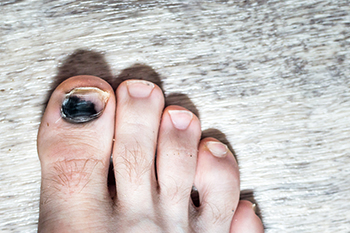
Blackened toenails are caused by repetitive pressure and friction, often occurring when the toe is forced against the front edge of a shoe's toe box. While sometimes referred to as tennis toe, blackened toenails can also affect athletes in soccer, football, squash, racquetball, basketball, running, and skiing. Symptoms include throbbing pain and a reddish-blue or black discoloration of the nail plate due to a subungual hematoma, which is caused by blood under the nail. The big toe is more commonly affected in blackened toenails, but the second toe may also be affected. Wearing ill-fitting shoes plays a pivotal role, causing friction that leads to bleeding under the toenail. In severe cases with significant bleeding, swelling, or infection, visiting a podiatrist is suggested. This foot doctor may relieve pressure on the subungual hematoma by making a small hole in the nail or, in extreme cases, recommend partial or complete nail removal. Prevention involves wearing well-fitted shoes and recognizing early symptoms. Whether you are an avid athlete or enjoy an active lifestyle, if you notice discoloration in the toenails, it is suggested that you schedule an appointment with a podiatrist for treatment solutions.
Toe pain can disrupt your daily activities. If you have any concerns, contact Dr. Thomas E. Silver of Westwood Foot Clinic. Our doctor can provide the care you need to keep you pain-free and on your feet.
What Causes Toe Pain?
Most severe toe pain is caused due to a sports injury, trauma from dropping something heavy on the toe, or bumping into something rigid. Other problems can develop over time for various reasons.
Toe pain can be caused by one or more ailments. The most common include:
- Trauma
- Sports injury
- Wearing shoes that are too tight
- Arthritis
- Gout
- Corns and calluses
- Hammertoe
- Bunions
- Blisters
- Ingrown toenails
- Sprains
- Fractures (broken bones)
- Dislocations
When to See a Podiatrist
- Severe pain
- Persistent pain that lasts more than a week
- Signs of infection
- Continued swelling
- Pain that prevents walking
Diagnosis
In many cases the cause of toe pain is obvious, but in others, a podiatrist may want to use more advanced methods to determine the problem. These can range from simple visual inspections and sensation tests to X-rays and MRI scans. Prior medical history, family medical history, and any recent physical traumatic events will all be taken into consideration for a proper diagnosis.
Treatment
Treatments for toe pain and injuries vary and may include shoe inserts, padding, taping, medicines, injections, and in some cases, surgery. If you believe that you have broken a toe, please see a podiatrist as soon as possible.
If you have any questions please feel free to contact our office located in Golden Valley, MN . We offer the newest diagnostic tools and technology to treat your foot and ankle needs.
